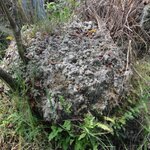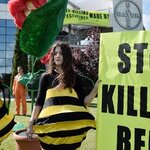Ecology & Zoology

Whole Foods shoppers and other anti-science groups may not like it, but scientists have taken the first step of an ongoing-process designed to bring a valuable heirloom wheat back from the brink of extinction.
Purple Straw is the only heirloom wheat to have been cultivated continually in the South from the Colonial Period into the last quarter of the 20th century. It remained a crop wheat until the 1970s, when it was then abandoned and replaced by more productive modern hybrids, but last month, Clemson University scientist Brian Ward and his team harvested about 145 pounds of Purple…

Six mating positions (amplexus modes) are known among the almost 7,000 species of frogs and toads found worldwide. However, the Bombay night frog (Nyctibatrachus humayuni), which is endemic to the Western Ghats Biodiversity hotspot of India, mates differently. In a new study, scientists have described a new (seventh) mode of amplexus -- now named as dorsal straddle.
In Bombay night frogs, the male does not embrace the female but straddles over her back with his hands holding or resting on substrates such as a leaf, branch or tree trunk. At this moment, the male appears to release sperm over…

A species of tropical fish has been shown to be able to distinguish between human faces. It is the first time fish have demonstrated this ability.
The research found that archerfish were able to learn and recognize faces with a high degree of accuracy -- an impressive feat, given this task requires sophisticated visual recognition capabilities. First author Dr. Cait Newport, Marie Curie Research Fellow in the Department of Zoology at Oxford University, said, 'Being able to distinguish between a large number of human faces is a surprisingly difficult task, mainly due to the fact that all human…

In the bird world, the color red has special significance. Many species use red signals to attract mates or deter rivals, adding the color to their beaks, feathers, or bare skin. Generally speaking, as far as many birds are concerned, redder is better. Now, two teams of researchers have independently identified an enzyme-encoding gene that allows some bird species to convert yellow pigments from their diets into that remarkable red. Their findings are reported on May 19 in Current Biology.
"To produce red feathers, birds convert yellow dietary pigments known as carotenoids into red pigments…

Mysterious spectacular mounds found in the earth in tropical wetlands in South America are created by earthworms, researchers have found.
The densely packed, regularly spaced mounds cover large areas of the Orinoco Llanos in Columbia and Venezuela. Until now it was not known how they were formed.
A new study shows these mounds, called surales, are largely made up of earthworm casts, heaps of muddy soil ejected by their guts. This is the first research to describe their formation.
This is a sural in the process of formation with earthworm aggregates on top. Credit: Professor José…

The Bee Informed Partnership conducts an annual survey of commercial and backyard beekeepers so that they can try and track health and survival rates of honey bee colonies. Though honey bees are just one bee species out of about 27,000, estimates of their implied economic value are around $10 billion annually. A The latest results show that honey bee colonies declined 44 percent during the year spanning April 2015 to April 2016.
That sounds alarming, and it is in contrast to studies showing that bee numbers are not in decline, but were instead at a 20-year high last year. (1)
How…

Vultures are often cartoon-ish characters in parched deserts. No one wants them around because in western films it means they are just waiting for you to die.
Cultural jokes aside, vultures in some parts of the world are in danger of disappearing. And according to a new report from University of Utah biologists, such a loss would have serious consequences for ecosystems and human populations alike.
The primary threat to vultures, according to the report published today in Biological Conservation, is the presence of toxins in the carrion they consume. On many continents, vultures are…
Researchers at the University of Maryland and the U.S.
Agriculture Department recently found that several parasites and the diseases
they vector into honey bee colonies are the source of most of the bee health
problems and supposed ‘die-offs’ observed in recent years[1].
Incidence of some relatively newly discovered
honey bee viruses is skyrocketing while three exotic and destructive threats to
honey bees have yet to make it to U.S. shores.
That’s quite a contrast to the narrative that anti-pesticide
activists have been pushing for the last half-dozen years. They insist…
Galileo is regarded as an important figure today, because he was put under house arrest by his church for ridiculing the Pope, but for much of his career he was derided by other scientists. Both Kepler and mathematics knew Galileo was wrong about the moon, for example, but his flavor of science insisted that the tides only happened once per day if they happened at all, they happened at the same time every day, and that Luna had nothing to do with them.
Sailors knew Galileo's data was wrong and now it turns out even coastal birds did. Many birds rely on the shallow water of the…

Madagascan Darwin's bark spider (Caerostris darwini) are a sexually size dimorphic species from Madagascar, with females several times larger and heavier than males.
If you want a weird science project for school, kids, these are the way to go. C. darwini has a rich sexual repertoire that not only involves sexual cannibalism and genital mutilation, but also oral sex. Males of this species routinely salivate onto female genitalia.
Oral sexual contact is rare in the animal kingdom, except in mammals, where fellatio-like behaviors are known in macaques, lemurs, bonobos, hyenas, cheetahs, lions…